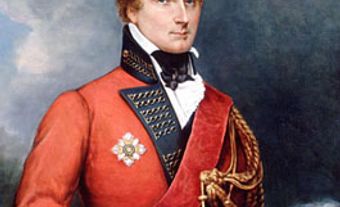
Charles-Michel d'Irumberry de Salaberry, British army and Canadian militia officer, military figure in the War of 1812 (b at Beauport, Qué 19 Nov 1778; d at Chambly, Lower Canada 27 Feb 1829). At age 14, de Salaberry enlisted as a volunteer in the 44th Foot. In 1794, through the patronage of Prince Edward Augustus, a family friend who later became the Duke of Kent, de Salaberry became an ensign in the 60th Foot.
De Salaberry's Early Career
De Salaberry distinguished himself during service in St. Domingo, Guadaloupe and Martinique before his first posting to Lower Canada, and returned to the West Indies in 1797. At the end of 1799, de Salaberry was promoted to captain and in June 1803, received command of a company in the 1st Battalion, 60th Foot. Early in 1806, de Salaberry was transferred to the 5th Battalion of the 60th Foot, which was commanded by Francis de Rottenburg, a pioneer in light infantry and rifle tactics. Between July 1806 and March 1807, de Salaberry was involved in recruiting. In June 1810, de Rottenburg was posted to Lower Canada and took de Salaberry with him as an aide-de-camp.
De Salaberry Commands the Voltigeurs
In July 1811, de Salaberry became a brevet major and in early 1812, as war with the US seemed imminent, he proposed raising a provincial corps, the Canadian Voltigeurs. Recruiting began in April and the unit became perhaps the finest provincial unit of the war. In the autumn of 1812, the Voltigeurs went to the frontier of Lower Canada and de Salaberry took charge of the border defences. He led the forces that repelled the Americans at Lacolle in November 1812, defended Odelltown in September 1813 and led an abortive raid on the American camp at Four Corners in early October 1813. He was then placed under the command of Major General Louis de Watteville, a Swiss officer in British service, who commanded the entire frontier. De Salaberry was responsible for defending the Lower Châteauguay River.
The Americans launched a major offensive against Montréal in the fall of 1813. A 3700-man division under Major General Wade Hampton was concentrated at Four Corners on the Châteauguay River, just south of the border with New York State. Another division was ready to move down the St Lawrence River to Montréal.
Hampton crossed the frontier on the 21st. De Salaberry had the advantage in being familiar with the terrain he was to defend. Following the attack on Hampton's camp, he had spotted a wooded and swampy area with ravines that intersected the Châteauguay River at right angles. When he learned the Americans were advancing toward this spot, de Salaberry turned it into a strong position. He had a polyglot mixture of 1800 regulars, provincial troops and embodied and sedentary militia; most of them were Canadiens. A contingent of First Nations warriors was also present. De Salaberry arranged his position in four lines on the west side of the river. A picket of warriors, light infantry and militia were placed ahead of the first line and another picket was established near a ford across the river.
The Americans attacked at first light on 26 October. One brigade advanced toward de Salaberry's main position, while another moved along the opposite shore. Both were stopped and soon in retreat. Hampton then returned to the US. One part of the American offensive had been thwarted and the second would end at Crysler's Farm in November.
De Salaberry's Final Years of Service
De Salaberry was so angered by the lack of recognition he received in the dispatch about the action released by Lieutenant General Prevost, the commander-in-chief of British North America, that he offered his resignation. The Duke of Kent intervened and de Salaberry remained in the army. He saw no other action during the war and relinquished command of the Voltigeurs in early 1814. He left the army in 1815 and settled near Chambly, where he became a wealthy landowner and businessman. He received an Army Gold Medal for Châteauguay and was made a companion of the Order of the Bath. He also became a member of the Legislative Council of Lower Canada. His military service had ruined his health and he died in 1829, at the age of 50.

 Share on Facebook
Share on Facebook Share on X
Share on X Share by Email
Share by Email Share on Google Classroom
Share on Google Classroom


